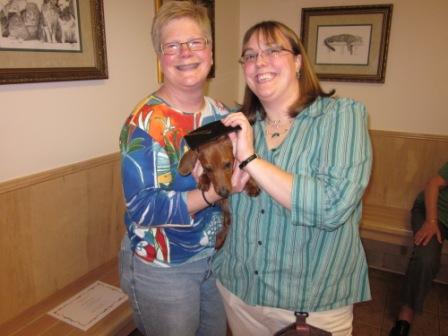What Do I Do If . . . ?
We’re Here To Help You
1. Handling exercise: As always, continue the previous exercises as directed.
A. Encourage other people to handle your puppy as you have been doing. Hand your puppy off to multiple people without acting upset and let the puppy learn that other people can handle it just as you do. Treats are a must.
B. If you are having trouble with nail trims, now is the time to ask for help and prevent future foot phobias. Please ask us if you are having problems.
2. Feeding exercises: Continue as before.
3. House training: Do not stop the umbilical method until your puppy has gone 4 weeks without an accident. Your puppy will get the idea eventually!
4. Problem behaviors: Still having trouble with barking, nipping, or jumping? Ask us for more training tips!
A. Chewing: Your puppy is probably teething right now and will chew on anything and everything! Have plenty of safe toys laying around for your puppy to chew on. Rope toys, nylabones, Kongs and similar toys are excellent for teething puppies. Always supervise your puppy with chew toys. If your puppy is chewing on something you don’t want chewed, firmly tell the puppy “No” and remove the item or the puppy, then offer the puppy a chew toy instead.
B. Pulling on the leash: Only use a 6 foot leash for this process. One way to teach loose leash walking is to keep the puppy at your side by luring it with treats and frequently rewarding the puppy for walking on a loose leash. If the puppy is pulling, turn and walk in the opposite direction so that the puppy learns you are the leader. Only walk forward when the leash is loose. For persistent pullers or if your puppy is too strong to handle comfortably, please ask for advice on training aides such as the Gentle Leader, Easy Walk Harness, and Halti.
5. Socialization – Make sure your puppy continues to interact with new people and is exposed to new locations. If at any point your puppy is afraid, do not pet or reward it; instead, take the puppy back to where it was comfortable, ask the puppy to sit or do something it likes to do, then try again, offering treats to encourage the puppy to investigate whatever may have startled it initially.
A. Children – It is always important to teach your puppy how to behave around children. Only let your puppy interact with children after it has been thoroughly exercised and is tired; this teaches the puppy to be calm and quiet around children. Nipping, barking, and excited behavior are never acceptable around children. Instead, teach the puppy to interact quietly with children by sitting, or laying down and allowing the child to pet the puppy. It is important for the child to not be excited or anxious around the puppy. Always be careful during this process and seek professional help if necessary.




